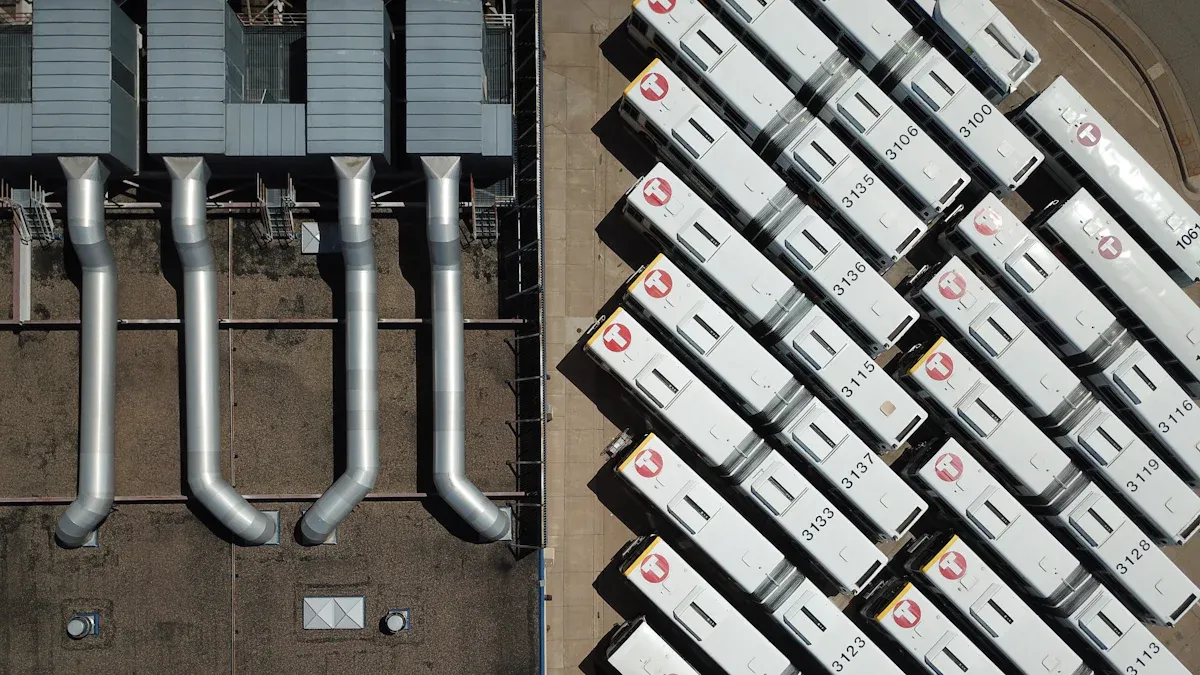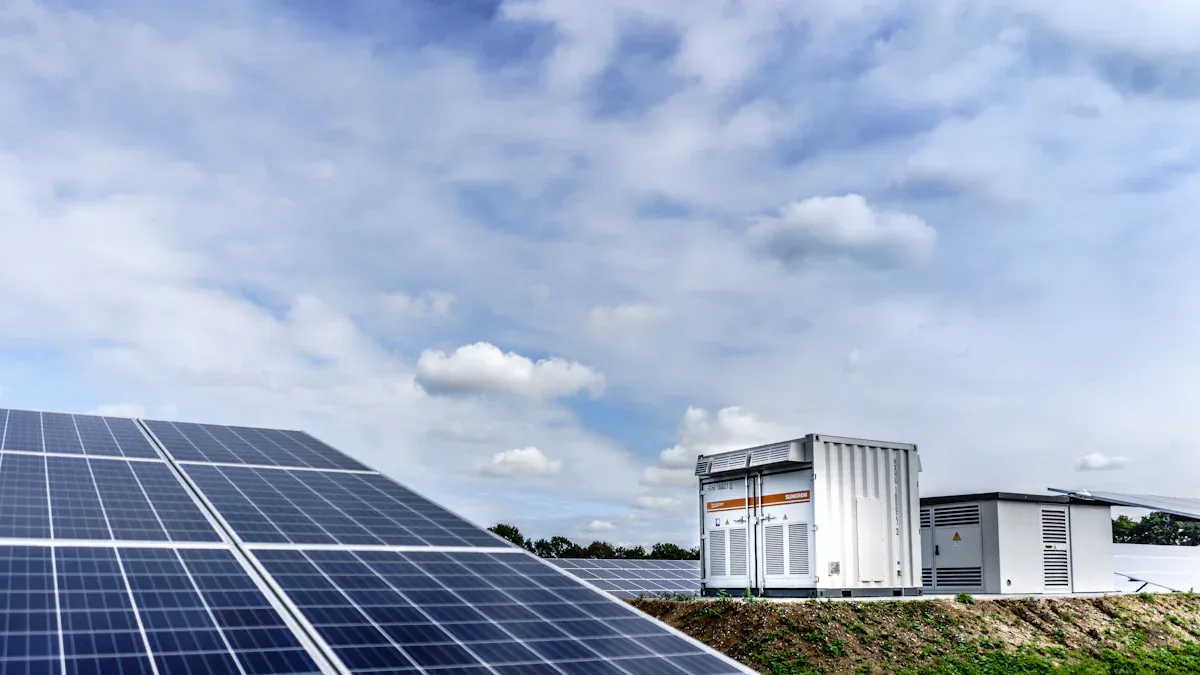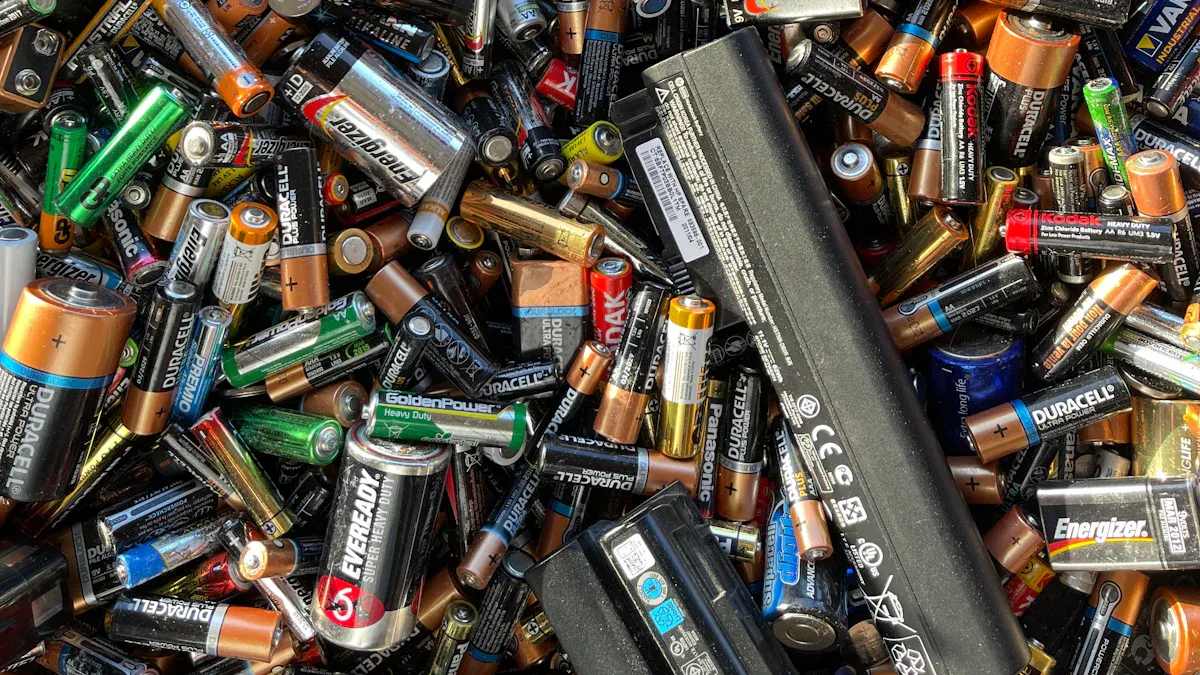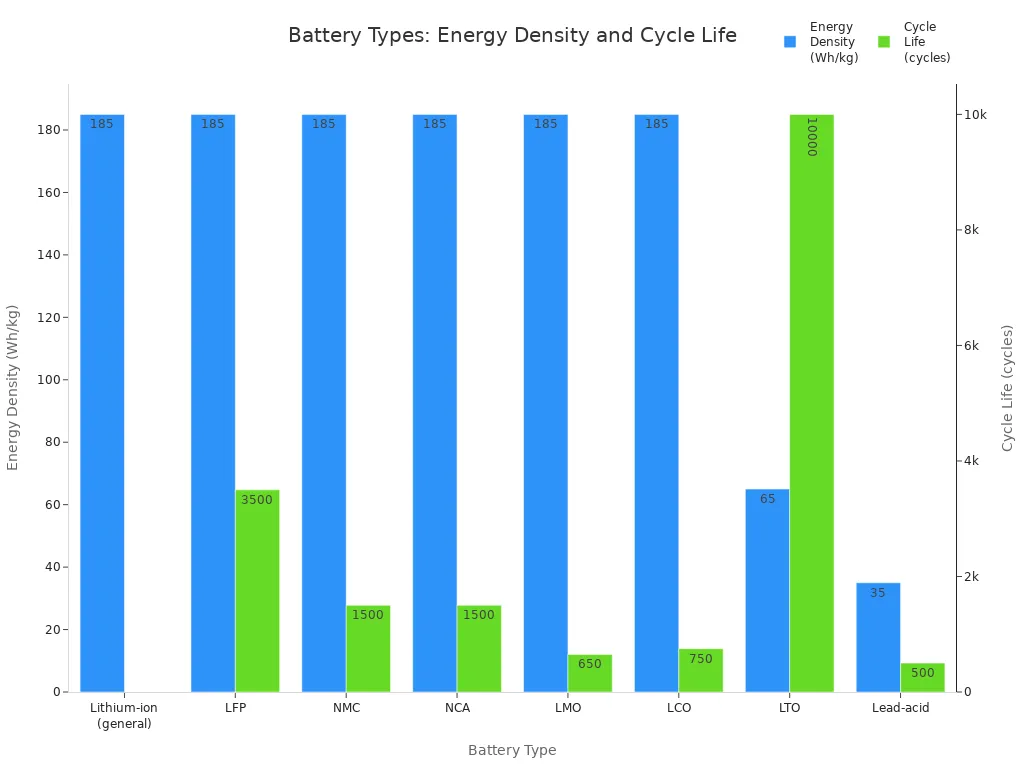What is a Battery Energy Storage System and How Does It Work

A battery energy storage system, or BESS, lets you store electricity when supply is high and release it when demand rises. You use a battery energy storage system to manage energy from the grid or renewable energy sources like solar and wind. Battery storage makes up about one-third of global energy storage capacity, expanding quickly because you can install it almost anywhere. With a BESS, you help balance electricity supply and demand, support grid reliability, and make better use of clean energy. Battery energy storage systems respond fast to grid changes, improve resilience, and reduce the need for fossil fuels. If you want a flexible energy storage system for your home or business, battery storage offers a smart solution.
Key Takeaways
A battery energy storage system stores electricity when supply is high and releases it when demand rises, helping balance energy and support renewable sources like solar and wind.
BESS includes key parts like batteries, power converters, thermal management, fire suppression, and smart software to keep energy safe, efficient, and reliable.
Different battery types such as lithium-ion, lead-acid, and flow batteries serve various needs, from home use to large-scale grid storage, each with unique benefits.
Using battery storage improves grid stability, supports clean energy, provides backup power during outages, and helps save money by shifting energy use to cheaper times.
Proper maintenance and recycling extend battery life, ensure safety, and reduce environmental impact, making energy storage a smart and sustainable choice.
How BESS Works

Charging and Discharging
You use a battery energy storage system to store electricity when it is available and release it when you need it most. The process starts when you charge the battery. During charging, the system converts electrical energy from the grid or renewable energy sources into chemical energy inside the battery cells. This chemical energy stays stored until you need to use it.
A battery has two main parts called electrodes: the anode (positive) and the cathode (negative). These electrodes sit in a special liquid called an electrolyte. When you charge the battery, electrical energy moves ions between the electrodes, storing energy as chemical changes. When you discharge the battery, the process reverses. The stored chemical energy turns back into electrical energy, which flows out to power your home, business, or the grid.
Charging and discharging in a battery energy storage system rely on controlled chemical reactions. These reactions allow you to store energy efficiently and release it quickly when demand rises.
Here is a simple breakdown of the process:
Electrical energy from the grid or renewable sources becomes chemical energy in the battery during charging.
The battery management system (BMS) monitors and controls the charging process to keep the battery safe.
The battery holds the chemical energy until you need it.
When you discharge the battery, chemical reactions inside the battery release electrical energy.
The system sends this electricity to your building or the grid.
An inverter changes the battery’s direct current (DC) output into alternating current (AC) for use with most appliances and the grid.
This cycle lets you use battery storage to balance energy supply and demand, support renewable energy, and improve grid reliability.
Main Components
A battery energy storage system includes several key parts that work together to store and deliver energy safely and efficiently. Each component plays a unique role in the operation of your energy storage system.
Batteries: These are the heart of your battery storage system. They store energy as chemical energy and release it as electrical energy when needed. Different types of batteries, such as lithium-ion or lead-acid, offer various benefits for energy storage.
Power Conversion System (PCS): The PCS manages the flow of energy in and out of your battery storage. It converts AC electricity from the grid or renewable energy sources into DC electricity for charging the batteries. When you need to use stored energy, the PCS converts DC back into AC. The PCS also helps regulate power, maintain grid stability, and support services like frequency regulation and peak shaving.
Thermal Management System: Batteries generate heat during charging and discharging. The thermal management system keeps the batteries at the right temperature, usually between 20°C and 25°C. This system uses sensors, cooling fluids, or air to prevent overheating, which can damage batteries or cause safety risks. Good thermal management extends battery life and improves the safety and efficiency of your energy storage system.
Fire Suppression System: Safety is a top priority in battery energy storage. Fire suppression systems use advanced technologies to detect and stop fires before they spread. These systems include vapor detection, smoke sensors, AI-powered monitoring, immersion cooling, water mist, gas-based suppression, and fire-resistant enclosures. For example, immersion cooling submerges batteries in a special liquid to prevent hot spots and fires. These technologies protect your battery storage and reduce the risk of thermal runaway.
Fire Suppression Technology | Description & Functionality | Key Benefits & Notes |
|---|---|---|
Electrolyte Vapor Detection | Detects volatile compounds from electrolyte breakdown for early warning. | Enables early intervention to prevent escalation. |
Smoke and Particle Sensors | Identifies microscopic combustion particles early. | Detects fires at the smoldering stage, allowing faster response. |
AI-Powered Predictive Monitoring | Uses machine learning to predict failures before they occur. | Proactive maintenance and risk reduction; integrated with BMS for automatic alerts. |
Immersion Cooling Technology | Submerges batteries in dielectric liquid to absorb heat and prevent hot spots. | Prevents fire by maintaining uniform temperature; liquid also suppresses flames if failure occurs. |
Water Mist Systems | Uses ultra-fine water droplets to cool overheating cells. | Reduces thermal runaway risk and limits fire spread. |
Gas-Based Suppression | Uses inert gases to displace oxygen and starve fire. | Leaves no residue; suitable for sealed battery rooms. |
Clean Agent Suppression | Uses chemical agents to absorb heat and suppress flames without residue. | Fast acting, safe for personnel and electronics. |
Fire-Resistant Enclosures | Fireproof cabinets contain fires and prevent spread. | Adds containment layer; critical in large-scale installations. |
Battery Management Software (BMS): The BMS acts as the brain of your battery energy storage system. It monitors voltage, current, temperature, and the state of charge and health of each battery cell. The BMS protects your batteries from overcharging, overdischarging, and overheating. Advanced software uses artificial intelligence to predict faults, optimize performance, and extend battery life. Cloud integration allows you to monitor your system remotely and receive alerts if something goes wrong.
A well-designed battery management system ensures your battery storage operates safely, efficiently, and reliably, even as your energy needs change.
When you combine these components, you get a complete battery energy storage system that can store solar energy, balance electricity supply and demand, and provide backup power. Modern battery storage technology gives you the flexibility to use energy when you need it most, making your home or business more resilient and efficient.
Types of Battery Energy Storage Systems

When you choose a battery energy storage system, you need to understand the different types available. Each type of battery storage offers unique advantages for specific energy storage needs. The table below gives you a quick overview of the most common battery energy storage technologies:
Battery Type | Key Characteristics | Common Applications |
|---|---|---|
Lithium-Ion | Homes, businesses, electric vehicles | |
Lead-Acid | Affordable, reliable, lower energy density, shorter lifespan | Backup power, off-grid, UPS |
Flow Batteries | Scalable, long lifespan, lower energy density | Utility-scale, grid storage |
Sodium-Ion | Safer, cost-effective, lower energy density | Emerging tech, high-temp environments |
Nickel-Cadmium | Robust, long cycle life, environmental concerns | Industrial, aviation, military |
Lithium-Ion BESS
Lithium-ion battery energy storage dominates the market because you get high energy density and long cycle life. These batteries can last up to 20 years and handle thousands of charge-discharge cycles. You find lithium-ion battery storage in homes, businesses, and electric vehicles. Lithium iron phosphate (LFP) and nickel manganese cobalt (NMC) are popular types. LFP batteries offer extra safety and longer life, while NMC batteries provide higher energy density for compact energy storage.

Lithium-ion battery energy storage systems deliver up to seven times more energy density than lead-acid batteries. This means you can store more electricity in a smaller space and use it for longer periods.
Lead-Acid BESS
Lead-acid battery storage remains a reliable and affordable choice for backup power and off-grid energy storage. You often see these batteries in uninterruptible power supplies (UPS), hospitals, and data centers. Lead-acid batteries have a shorter lifespan—usually 5 to 10 years—and lower energy density than lithium-ion. However, you can count on them for grid stabilization, renewable energy integration, and emergency backup.
Renewable energy storage for solar and wind systems
Flow Battery Systems
Flow battery energy storage systems use liquid electrolytes to store and release energy. You can scale these systems easily by increasing tank size, making them ideal for large-scale grid storage. Flow batteries last up to 25 years with minimal degradation. They use non-flammable materials, so you get improved safety and sustainability. Flow batteries work best for long-duration energy storage, such as balancing renewable energy on the grid.
Flexible, scalable design for utility-scale projects
Other Technologies
You also have access to emerging battery storage options. Sodium-ion and zinc-based batteries offer safer, more sustainable energy storage for stationary and high-temperature environments. Iron-air batteries provide long-duration storage for grid balancing. Organic flow batteries use eco-friendly materials and suit data centers. Gravity-based storage lifts heavy weights to store energy without chemical reactions.
You can choose between pre-packaged battery modules for easy scalability and maintenance, or custom battery banks tailored to your specific needs. Modular systems let you expand capacity by adding more units, while custom banks fit unique applications but may require more complex maintenance.
Choosing the right battery energy storage system depends on your energy goals, budget, and application. Whether you need backup power, renewable energy storage, or grid support, you have a range of battery storage solutions to meet your needs.
Benefits and Uses of Energy Storage
Grid Stability
You help stabilize the grid when you use battery energy storage. During peak demand, your system discharges stored energy to balance supply and demand. This reduces the need for expensive and less efficient generators. Battery energy storage supports grid resilience during outages and helps prevent blackouts. You also improve energy security by reducing the impact of fuel price changes and supply disruptions.
Explanation | |
|---|---|
Store energy during low demand and release it during high demand, smoothing demand peaks. | |
Peak Shaving | Discharge extra power during peak hours, lowering reliance on costly peaking plants. |
Grid Stability | Smooth demand fluctuations and reduce peak spikes, enhancing reliability. |
Cost Savings | Lower the need for expensive peak-time generation and upgrades. |
Renewable Integration | Store excess renewable energy and provide power when intermittent sources are unavailable. |
Environmental Benefits | Lower carbon emissions by reducing fossil fuel use and energy waste. |
Battery energy storage systems provide ultra-fast frequency response, often supplying most of the frequency-regulation capacity during disturbances. This fast action prevents generator disconnections and keeps the grid stable.
Renewable Integration
You can use battery energy storage to make renewable energy more reliable. Solar energy storage lets you save extra power from sunny days and use it when the sun goes down. Wind power also becomes more useful when you store energy for later. Your system balances supply and demand, reducing blackout risks and ensuring steady power. Battery energy storage helps utilities move away from fossil fuels and supports a cleaner grid.
Store energy from solar and wind for use during cloudy or calm periods.
Respond quickly to changes in supply and demand.
Support hybrid clean energy systems for consistent power.
Enable distributed solar energy storage for community resilience.
Backup Power
You gain reliable backup power with a battery energy storage system. When the grid goes down, your system provides instant, emission-free electricity. This keeps hospitals, communication systems, and water treatment plants running during emergencies. You can also use battery energy storage in microgrids, allowing your facility to operate even if the main grid fails. The rapid response of battery energy storage prevents blackouts and voltage drops, making your energy supply more secure.
Cost Savings
You save money with battery energy storage by charging your system during off-peak hours and discharging during peak demand. This process, called load shifting, lowers your electricity bills. Businesses reduce demand charges by using stored energy instead of drawing from the grid during expensive periods. As the cost of battery energy storage drops, both commercial and residential users see greater savings. Solar energy storage also lets you use more of your own solar power, reducing reliance on costly grid electricity.
Lower energy costs by shifting use to cheaper times.
Reduce demand charges for businesses.
Support participation in demand response programs.
Benefit from falling battery prices and improved cost-effectiveness.
Lifespan and Maintenance of Energy Storage Systems
Typical Lifespan
When you invest in a battery energy storage system, you want to know how long it will last. Most lithium-ion battery energy storage systems work for 10 to 15 years under normal conditions. The lifespan depends on how often you charge and discharge the batteries, the temperature where you keep them, and how deeply you use the stored energy each cycle. Premium models can last even longer if you take good care of them.
Aspect | Details |
|---|---|
Average Lifespan | |
Cycle Life | 6,000 to 10,000 cycles before capacity dip |
Usage Pattern Impact | More frequent cycling shortens lifespan |
Battery Type Influence | Lithium-ion preferred; LFP batteries hold ~60% market share |
Summary | Lifespan typically 10-15 years under normal conditions, depending on care and usage patterns |
You can extend the life of your battery energy storage by keeping the system at the right temperature, avoiding deep discharges, and following the manufacturer’s guidelines.
Maintenance Needs
You need to perform regular maintenance to keep your battery energy storage system safe and reliable. Most modern systems have built-in monitoring software that checks battery health, temperature, and charge levels. You should:
Inspect the system for dust, corrosion, or leaks.
Check cables and connections for wear.
Monitor the battery management system for alerts.
Keep the area around the system clean and cool.
Tip: Operating your battery energy storage at around 25°C helps maximize lifespan and safety.
If you notice any warning signs, such as swelling or unusual heat, contact a professional right away. Proper maintenance reduces the risk of failure and helps you get the most out of your energy investment.
Recycling and Repurposing
When your battery energy storage system reaches the end of its life, you have several options to reduce environmental impact and recover valuable materials. Recycling and repurposing help conserve resources and prevent pollution.
Common steps for recycling and repurposing include:
Sorting and manual disassembly to remove hazardous parts.
Mechanical shredding to create a mix called "black mass."
Chemical refining to separate and purify metals like lithium, cobalt, and nickel.
Reusing recovered materials in new batteries or other products.
Giving batteries a second life in stationary energy storage or backup power systems if they still hold enough capacity.
Second-life applications can include backup power for hospitals or use in light electric vehicles.
Recycling reduces landfill waste, saves energy, and cuts greenhouse gas emissions.
Manufacturers and users share responsibility for safe disposal and recycling.
Note: Battery production and disposal can harm the environment if not managed well. Recycling and repurposing are key to a cleaner, more sustainable energy future.
You now understand that a battery energy storage system lets you store and use electricity when you need it most. These systems help you balance energy supply, support renewable energy, and keep the grid stable. Recent advances have made energy storage more reliable and affordable. For example, the global market for battery energy storage is set to grow rapidly:
Year | Market Size (USD Billion) |
|---|---|
2024 | |
2032 | 114.05 |
You can use energy storage to lower costs, reduce pollution, and protect against outages.
New battery technologies promise even better performance and safety.
As you look to the future, consider how energy storage can help you build a cleaner, more resilient world.
FAQ
What is the main purpose of a battery energy storage system?
You use a battery energy storage system to store electricity and release it when demand rises. This helps you balance supply and demand, improve grid reliability, and support renewable energy sources like solar and wind.
How does a battery management system keep batteries safe?
You rely on a battery management system to monitor voltage, temperature, and charge levels. It protects batteries from overheating, overcharging, and deep discharges. This system helps you extend battery life and maintain safe operation in your energy storage system.
Can you use battery energy storage systems with solar panels?
You can connect battery energy storage systems to solar panels. Solar energy storage lets you save extra electricity produced during sunny hours. You use this stored energy at night or during cloudy weather, making renewable energy more reliable for your home or business.
What types of batteries are used in energy storage systems?
You find lithium-ion, lead-acid, and flow batteries in energy storage systems. Lithium-ion batteries offer high energy density and long life. Lead-acid batteries provide affordable backup power. Flow batteries work well for large-scale renewable energy storage systems.
How do you maintain a battery energy storage system?
You inspect cables, monitor the battery management software, and keep the area clean. You check for signs of wear or overheating. Regular maintenance helps you ensure your battery storage technology works efficiently and safely for many years.